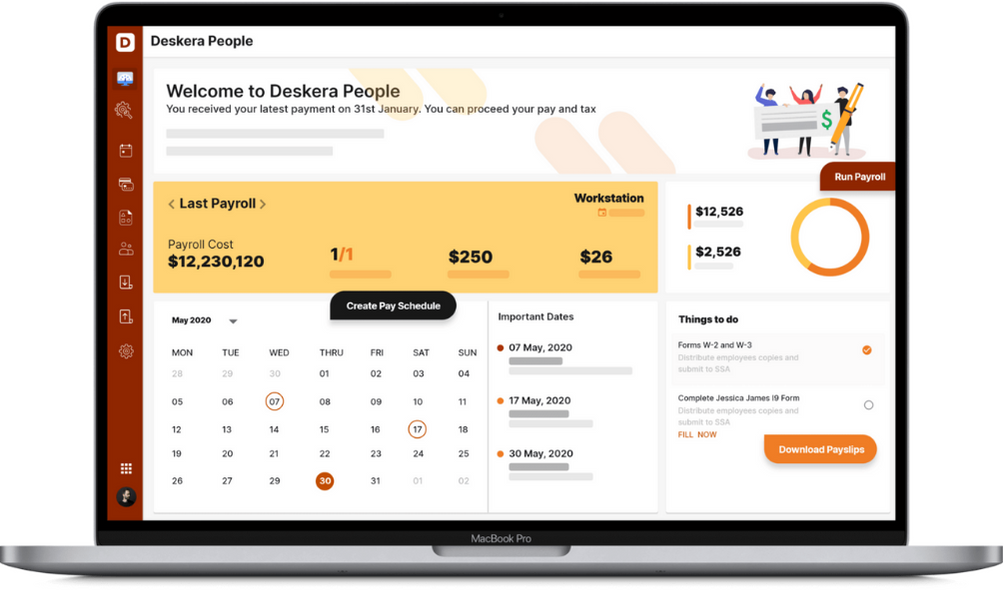1,620,806 total Work Opportunity Tax Credits were given in the United States in 2020. The Work Opportunity Tax Credit (WOTC) is a federal tax credit that firms can claim if they hire people from underrepresented groups. The employee categories are people who have faced major job hurdles. The deadline for applying for this tax credit has been extended until December 31, 2025.
Table of contents
- What exactly is WOTC?
- Understanding the Work Opportunity Tax Credit (WOTC)
- IRS Form 8850
- Form 9061
- The Work Opportunity Tax Credit's Benefits and Drawbacks (WOTC)
- How to Determine a Worker's Qualifications?
- Wages Counted for the Tax Credit
- How To Apply for the Work Opportunity Tax Credit?
- The WOTC's Impact on Business Taxes
- What is the procedure for applying?
- What is a WOTC screening, and how does it work?
- What is the purpose of the Work Opportunity Tax Credit for employees?
- What Kinds of Tax Credits Does the General Business Credit Cover?
- Ongoing Tax Credits
- Taking advantage of the Work Opportunity Tax Credit (WOTC)
- Tax Deductions vs. Tax Credits
- Is WOTC Beneficial to Employees?
- Tax Credit for Retention of Employees
- Tax Deductions for Small Businesses
- What is the maximum amount of Work Opportunity Tax Credit that can be claimed?
- The certification and screening process for the Work Opportunity Tax Credit
- Key Takeaways
What exactly is WOTC?
The Work Opportunity Tax Credit (WOTC) is a federal tax credit given to firms that invest in job searchers in the United States who have persistently faced employment hurdles. Employers who recruit someone from a WOTC targeted group might meet their business needs while also claiming a tax credit.
Before claiming the work opportunity tax credit, employers must apply for and get certification that the new hire is a member of a targeted category. Taxable employers claim the work opportunity tax credit (WOTC) as a general business credit against their income taxes, whereas tax-exempt employers claim the work opportunity tax credit (WOTC) against their payroll taxes after obtaining the requisite certification.
Understanding the Work Opportunity Tax Credit (WOTC)
The Internal Revenue Service (IRS) administers the work opportunity tax credit (WOTC), which is jointly administered by the Department of Labor (DOL) and the United States Treasury (IRS). State agencies that administer the certification process receive grant funding and policy direction from the Department of Labor, while the IRS is in charge of tax-related regulations for claiming the credit.
The Protecting Americans from Tax Hikes Act of 2015 (PATH Act) permits qualifying companies to claim the wotc retroactively for employees employed between December 31, 2014, and December 31, 2020.
To claim the employment opportunity tax credit, employers must confirm that a potential employee is a member of a targeted group. Work opportunity tax credit (wotc) entails completing many forms containing information from both the employee and the company.
IRS Form 8850
Employers have 28 days from the start date of a qualified employee to send Form 8850, commonly known as the WOTC Pre-Screening Notice and Certification Request, to the appropriate SWA.
The first page describes the prerequisites that someone from one of the target groups must achieve to qualify for the programme, and it must be completed by the applicant on or before the day of the employment offer. The second page is for employers only. They'll include their company's contact details as well as the applicant's crucial employment dates.
Form 9061
A second form, this time for the Department of Labor, must be filled out. The employee fills out DOL Form 9061, and the employer must double-check the information with supporting documents.
Depending on which targeted category the employee belongs to, such documents may include a copy of the employee's birth certificate, military discharge papers, or records of receiving SNAP or SSI assistance.
If an employee has already been conditionally certified, which means they've been tentatively designated as a member of a target group, the employer can use DOL Form 9062 instead.
The employer's state workforce agency makes conditional certification decisions, and Form 9062 serves as an official record of pre-certification. When sending in Form 8850, the employer must also submit Form 9061 or 9062.
The Work Opportunity Tax Credit's Benefits and Drawbacks (WOTC)
Tax credits can assist businesses in lowering their tax liabilities, which can be beneficial to their bottom line. That is true for the job opportunity tax credit as well as any other business tax credit.
Another benefit of the credit is that it encourages more diverse hiring. From the standpoint of a worker, this tax credit may make it easier for some groups to find jobs that would otherwise be missed in the recruiting process.
On the other hand, meeting certification and filing requirements may be the most difficult hurdle for employers. While the paperwork isn't difficult, companies must make sure that they're filling out documents accurately and on time to pre-screen and certify staff. To claim the credit, they must also keep correct records of their employees' hours and wages earned throughout their first year of employment.
How to Determine a Worker's Qualifications?
Both the employer and the applicant must complete two forms during the hiring process, either before or on the day the employee starts work. You won't be able to collect the tax credit if you don't fill out the documents during the hiring procedure.
To begin work opportunity tax credit, fill out IRS Form 8850, the IRS pre-screening form, with the applicant. When a job offer is given, the applicant fills out the first page of the application to demonstrate their eligibility. When the candidate is hired, you, as the employer, fill out the second page, which includes your information as well as information on the individual who was hired.
DOL Form 9061 must be completed by both you and the applicant. The applicant fills out the application, and the employer checks the identifying documents they provide. Some candidates may have already completed DOL Form 9062, Conditional Certification.
You must submit Forms 8850 and 9061 to the state workforce or employment agency as soon as the employee is hired for a determination of the worker's eligibility for WOTC credit. The forms must be submitted by the 28th calendar day after the employee starts working.
Employers can submit a work opportunity tax credit (WOTC) application online in several states.4 For information on how to apply, contact your state's workforce or employment agency.
A determination letter is sent to the employer once the state agency validates the worker's eligibility status.
Wages Counted for the Tax Credit
After the employee has been employed, the following step is to calculate the number of wages that will be used to calculate the tax credit for that employee.
To be eligible, the wages must be paid in the first year of employment, and the employee must have worked 120 hours in that year. As a result, you may need to wait until an employee has worked 120 hours before filing and qualifying for the credit.
If the employee works at least 120 hours in the first year, you can claim a tax credit of 25% of the wages, and 40% if the person works at least 400 hours. Each employment category has a maximum number of hours.
How To Apply for the Work Opportunity Tax Credit?
You can claim the tax credit by filling out and submitting one of two forms, depending on your business type, after the worker is employed and you obtain a letter from your state's workforce agency indicating that the worker qualifies.
Partnerships, S companies, cooperatives, estates, and trusts should use IRS Form 5884.
For all other taxpayers and business owners, use IRS Form 3800, the General Business Credit.
To complete this form, add all qualified workers' wages, based on hours worked and category, and multiply the total by the number of hours worked during the year and the appropriate percentages. The form is attached to the tax return and is used to calculate the tax liability of a corporation or an individual.
The WOTC's Impact on Business Taxes
The credit, along with other tax credits, can be applied against a business's income tax liability for the year in a certain order.
The type of business determines which tax form is used to claim the tax credit. WOTC (work opportunity tax credit) applications are included on Form 1040 by pass-through enterprises in which the business's income and loss are passed through to the owners.
What is the procedure for applying?
Complete IRS Form 8850, pre-screening of personnel and a request to have a newly hired employee certified as a member of the WOTC target group are both covered by Form 8850.
Complete ETA Form 9061- The worker's individual characteristics are listed on Form 9061 (Individual Characteristics Form). These include demographic information and other facts that reveal whether or not the applicant is a member of a WOTC target group.
In the absence of unemployment insurance wage records, the ETA Form 9175 (Long-Term Unemployment Recipient Self-Attestation) should be used.
Complete and submit all forms - Within 28 days of the new hire's start date, the forms must be filed with the state workforce agency. If you don't do so, your application will be declined.
For each WOTC application, the state workforce agency will make a final decision. It's possible that more information or paperwork is required. After receiving a certification, an employer can file a tax credit claim with the IRS.
Claim your tax credit. In most cases, an employer will claim the tax credit by completing Form 5884. If the organisation is tax-exempt and hiring veterans, he or she should instead fill out Form 5884-C (Work Opportunity Credit for Qualified Tax-Exempt Organizations Hiring Qualified Veterans).
What is a WOTC screening, and how does it work?
The WOTC screening process is used by companies to see if potential hiring qualifies for inclusion in the tax credit calculations. Employees must meet standards based on the number of hours they work and if they belong to a qualifying worker category.
For federal tax credit qualifying purposes, the employer and candidate fill out IRS Form 8850, a pre-screening form for the state workforce agency, and Department of Labor Form 9061. When the state agency confirms that the employee is qualified, the employer can apply to the IRS for tax credits on behalf of all employees.
What is the purpose of the Work Opportunity Tax Credit for employees?
While personnel employed through the WOTC programme do not receive additional compensation for being in a special category, they do have a better probability of being hired.
The tax credit may be worth anywhere from $1,500 to $9,600 per qualified employee, giving employers an incentive to hire someone who isn't as qualified or experienced as other candidates.
What Kinds of Tax Credits Does the General Business Credit Cover?
During the economic downturn, the Employee Retention Credit was introduced to assist firms in keeping employees on the payroll. For the period of March 12, 2020, to December 31, 2020, your business can receive a fully refundable tax credit equal to 50% of qualified employees' pay.
For the period of January 1, 2021, to December 31, 2021, the credit is increased to 70% of eligible wages. Reduce your employment tax contributions and/or receive an advance payment to take advantage of the credit. The deadline for claiming this tax credit has been extended to December 31, 2021.
Other COVID-19-related tax credits assist small businesses (those with fewer than 500 employees) in obtaining tax credits for offering sick leave and family leave benefits to their employees.
Employers can claim the credit by decreasing their federal employment tax deposits or claiming it on their quarterly federal tax returns. The duration of this programme has been extended till September 30, 2021.
Ongoing Tax Credits
The following credits are included in the general business credit. In parenthesis, you'll find the form you'll use to calculate each credit. Credit for alternative vehicles (Form 8910). This credit is made up of the following credits for vehicles you've put into service.
Credit for biodiesel and renewable diesel fuels (Form 8864)- This credit is for certain types of gasoline that you sell or use in your business.
On certain employee tips, employers can claim a tax credit for social security and Medicare taxes paid (Form 8846). This credit is usually equal to the portion of social security and Medicare taxes paid by your (employer) on tips received by employees of your food and beverage establishment where tipping is customary.
Whether the food is consumed on or off your business premises, you will receive a credit. See Form 8846 for further information.
Employer differential wage payments are credited (Form 8932). This credit incentivizes some small businesses to pay wages to employees who are serving in the uniformed services of the United States for more than 30 days.
Employer-provided childcare facilities and services are eligible for reimbursement (Form 8882). This credit is for eligible child care expenses paid by employees as well as qualified child care resources and referral services paid by employers.
Increased research activities deserve credit (Form 6765)- This credit is intended to encourage companies to boost their spending on research and experimental activities, such as energy research.
Credit for the costs of establishing a small-business pension plan (Form 8881)- This credit is for the costs of establishing a new qualified defined benefit or defined contribution pension plan.
There are numerous credits available for renewable energy, alternative fuels, and non-conventional fuels. Renewable power, geothermal and solar energy, fuel cell energy, biofuels, and other credits are among them. Learn more about how to save energy and run a business that is environmentally friendly.
Credit with restricted access (Form 8826) - This is a nonrefundable tax credit for a small business that pays or incurs expenses to offer accessibility to people with disabilities. The costs of complying with the Americans with Disabilities Act of 1990 must be paid or incurred by your company.
Community employment credit and empowerment zone (Form 8844) - If you have employees and operate a business in an empowerment zone or renewal community that qualifies for the credit, you may be eligible.
Credit for work in India (Form 8845) - This credit is for salary and health insurance expenditures paid or incurred for eligible employees.
Credit for emerging markets (Form 8874) - This credit is available for qualified equity investments in qualified community development organisations.
Credit for non-conventional fuel sources (Form 8907) - This credit is for eligible coke and coke gas you generated during the tax year and sold to an unrelated person.
Credit for plug-in electric vehicles that meet certain criteria (Form 8936)- This credit is for new eligible plug-in electric drive motor vehicles purchased during the tax year and put into service. Form 8936 contains extra information, including what qualifies as a certified plug-in electric drive motor vehicle.
Credit for work experience (Form 5884) - This credit incentivizes firms to recruit people from specific categories, such as those with a high unemployment rate or who have special job needs.
Credits are subject to a number of restrictions. The credit is only good for the amount of business income tax or Social Security tax that is owed.
The credit can be applied against a taxable business's business income tax due, and the regular carry-back and carry-forward conditions apply.
The credit is limited for qualified tax-exempt organisations to the amount of employer Social Security tax owed on all wages paid to all employees during the credit period.
Taking advantage of the Work Opportunity Tax Credit (WOTC)
Employers must figure out how many hours an employee worked and how much they were paid in their first year of employment to compute the credit. The credit that an employer can claim is restricted to the amount of business income tax or Social Security tax that is owed.
Tax Credits to Lower Your Company's Taxes
Some business owners associate the term tax credit with something positive, but they are unsure what it entails or how it differs from tax deductions.
Tax credits, as you will see, are preferable to deductions. Take a look at some of the most frequent tax credits available to businesses to help them save money.
Tax-exempt Employers
Qualified tax-exempt organisations described in IRC Section 501(c) and exempt from taxation under IRC Section 501(a) are eligible to claim the credit for qualified veterans who started working for them after 2020 and before 2026.
Tax-exempt employers can claim the credit against their employer's Social Security tax by filing Form 5884-C, Work Opportunity Credit for Qualified Tax-Exempt Organizations Hiring Qualified Veterans, separately after obtaining the required certification (Form 8850).
After submitting the appropriate employment tax return for the period for which the credit is claimed, complete Form 5884-C. Qualified tax-exempt businesses should not minimise their necessary deposits in expectation of credit, according to the IRS. The credit will have no impact on the employer's Social Security tax liability as shown on the employment tax return.
You should keep these things in mind
Any correspondence should include the employer's name, address, and Federal Employer Identification Number (FEIN).
Employers who use employer representatives to complete their tax requests may not have their certificates mailed to them until the UIA's WOTC Unit receives a certified original or notarized copy of the Power of Attorney.
The employer is responsible for hiring the worker for the required amount of hours after receiving the certification notification. Work Opportunity Credit, IRS Form 5884, is filed with your federal tax returns. It can be obtained on the IRS website or by calling 1-800-829-1040 toll-free.
Tax Deductions vs. Tax Credits
Businesses and people are given tax credits as incentives for specific types of activities. Businesses, for example, might receive tax credits for acquiring energy-efficient vehicles or building using environmentally friendly materials.
The activities in the situations below improve the economy, the environment, or business development, or serve other beneficial business objectives. A tax credit is usually only available for a limited time.
Tax credits outperform deductions in terms of tax savings. Tax credits are deducted from gross income before it is calculated. In the following step of the tax procedure, tax deductions are used to reduce net taxable income.
Purchase Tax Credits are a type of tax credit that can be used to offset the cost
For tax credits on business purchases, you must have purchased and put the equipment, vehicle, or facility into service (that is, you must have started using it) in the year you claim the credit.
Is WOTC Beneficial to Employees?
The Work Opportunity Tax Credit (WOTC) is known for saving businesses money on their tax bills, but it also benefits employees and potential employees in a variety of ways. Employers are not obligated to hire based on WOTC, but they are permitted to do so and it is common practice.
Some of the most popular industries for WOTC are call centres, restaurants/food chains, retail, staffing, franchising, distribution centres, casinos, convenience stores, health care, manufacturing, and hospitality, which all offer entry-level roles with significant turnover.
WOTC has certain target groups for whom it incentivizes firms in various areas to assist in the re-employment of historically underemployed populations. These individuals have suffered substantial job difficulties and are eager to return to work and contribute to their communities and families.
SNAP beneficiaries continue to be the largest group to benefit from the WOTC, accounting for 66 percent of those who qualify.
These incentives can help employers give more veterans and ex-felons an opportunity to get back to work and contribute to the economy and their communities, especially if they are struggling to reintegrate into the civilian sector.
Many states provide additional incentives for veterans because they believe in giving those who have served the country honourably an opportunity.
Veterans bring a unique set of talents to the table, including great leadership, teamwork, and self-control. Congress and the states agree that veterans should be given every opportunity to reintegrate into society. Getting ex-felons back to work can also benefit states by lowering reincarceration rates and benefiting from their economic effect.
Those in the TANF, LFTAR, or LTU categories appreciate the chance to return to work. The chance to be off public assistance motivates these employees to do especially well in their jobs, and employers notice that they tend to stay with the company long-term as a result of the relationship they've created via the possibility.
Furthermore, WOTC has saved the government and taxpayers money by removing more people from public assistance and reducing the number of federal benefits that would otherwise be paid.
Between 2002 and 2013, approximately 1.8 million certifications were issued for the TANF and long-term TANF target groups (approximately 20% of certifications), resulting in $130.9 billion in federal savings, according to studies by Dr Peter Cappelli of The Wharton School at the University of Pennsylvania and Department of Labor (DOL) statistics.
Dr Cappelli predicts that the federal savings from not having to pay benefits for the newest group, SSI, will be close to $28,000 per person. While not all target groups have identical estimates, overall federal savings are anticipated to be close to half a trillion dollars since the programme began in 1996.
These savings for the government and businesses are passed on to taxpayers and employees who can take advantage of the WOTC. Overall, WOTC benefits employees by giving them a voice and reminding companies that these populations are struggling, but that if given the correct chances, they are ready and willing to work.
Each of these groups brings to the workforce underutilised skill sets that can assist fill the labour shortages that some industries and states are experiencing. Policy regarding WOTC will continue to evolve over time, and different portions of the population will be affected.
Tax Credit for Retention of Employees
The IRS created an employee retention tax credit as part of the 2020 CARES Act to encourage firms to keep people on their payrolls.
This fully refundable tax credit was for 50% of the qualifying employee salary paid after March 12, 2020 (up to $10,000).
The credit was increased to 70% of eligible salaries, including the cost of health insurance, as of Jan with a ceiling of $7,000 per employee every quarter. The credits have been extended until December 31, 2021, thanks to the passing of the American Rescue Plan Act (ARPA).
Employers who take out Paycheck Protection Program (PPP) loans may be eligible for this tax credit, but only for wages paid with forgiven PPP funds. In some cases, group health plan expenses can be deemed qualifying wages.
Employees on Sick Leave and Family Leave are eligible for tax credits
Employers who provide sick leave and family leave to their employees are eligible for tax benefits under the 2020 Families First Coronavirus Response Act (FFCRA).
These credits are for small and mid-size businesses (those with less than 500 employees) that provide paid sick days to employees who are sick or caring for someone else. Employees who are caring for a child are also entitled to paid family leave.
Employers who covered these costs can claim a tax credit for a portion of the cost of delivering these benefits to their workers. They can take advantage of the tax credits by postponing the employer's portion of Social Security benefits on the income of their employees.
The programme was set to expire on Dec. 31, 2020, but Congress extended the credits under the ARPA, first until March 31, 2021, and then until Sept. 30, 2021.
Health-Care Tax Credit for Small Businesses
A small employer health insurance tax credit is included in the Affordable Care Act (commonly known as Obamacare) to encourage small businesses to offer health insurance for the first time or to keep the coverage they already have.
Small enterprises that pay at least half of the cost of single coverage for their employees are eligible for the credit. You can claim a credit of up to 50% of the health insurance premiums you paid for employees, but not for yourself as the business owner if your company and plan match the requirements.
Tax Credit for Research and Development
For many years, research and development tax credits have been available, but many small business owners are unaware that they are eligible. This credit is intended to help you increase your research activity. You can apply as a lone owner, a partnership, or a non-public corporation.
Tax Credit for People with Disabilities
Disabled access tax credits may be available if you make adjustments to your business location to accommodate disabled employees and consumers.
To be eligible for this credit, your company must have earned $1 million or less in the preceding year and had no more than 30 full-time employees.
Tax Credits and Deductions for "Going Green" in Business
Tax credits may be available if you make adjustments to your business's equipment to make it more energy-efficient or environmentally friendly. You may be entitled to tax deductions in addition to tax credits for upgrades made to your business facilities.
The Business Energy Tax Investment Credit, for example, rewards businesses for purchasing or installing energy-saving technologies like fuel cells and wind and solar energy.
To be eligible, your company must own or build the equipment, and it must meet certain quality and performance requirements.
New All-Electric and Plug-in Hybrid Vehicle Tax Credits
You may be eligible for a $7,500 federal income tax credit if you purchase a new all-electric or plug-in hybrid vehicle. The credit amount is determined by the type of battery used to power the car. You can't use the credit to buy a used car for your company.
The credit is only valid for automobiles purchased after December 31, 2009, and it will phase out once 200,000 qualifying vehicles have been sold. Use IRS Form 8936 Qualified Plug-In Electric Drive Motor Vehicle Credit to claim the credit.
Tax Deductions for Small Businesses
Fees for legal and accounting services, as well as tax preparation
You may choose to engage and pay an attorney for legal services, as well as someone to handle your bookkeeping and accounting, prepare tax returns, and provide tax advice. These professional services are company expenses that are tax-deductible.
Legal and accounting fees for assistance with business startup or acquisition of business assets are not deductible, but they can be included in the cost of your business or asset.
You can't deduct the personal portion of a fee if an accountant or attorney prepares your tax return or does other work that incorporates both business and personal services.
Expenses for advertising and marketing
You can deduct expenses that assist you to bring in new consumers and retain existing customers, regardless of whether you call it advertising, marketing, or promotion.
You can also deduct costs associated with keeping your name in the public eye, such as advertising that encourages people to donate to charities.
However, one of the most common deduction blunders made by business owners is attempting to deduct the costs of driving around with a business advertisement on your car. The cost of the advertisement is deductible, but not the expense of driving around with the advertisement on the automobile.
Computers, Tablets, and Cell Phones
Purchases of relevant reference books, as well as computer gear and software, can be deducted. As long as the cost of these things is less than $2,500, depreciation is no longer required.
Only the use of your computer or iPad for business purposes is deductible. As of the 2018 tax year, computers, tablets, and related hardware and software are not considered listed property, but you should still use them for business purposes more than 50% of the time.
Using a Car or Truck for Professional Purposes
The IRS standard mileage rate or actual expenses can be used to deduct expenses connected to the business use of your car.
The standard mileage rate varies from year to year, so make sure you know what it is for the current tax year. Calculate both options (standard vs. actual mileage) to see which is best for your company.
Keep in mind that there are certain limitations; for example, if you depreciated the cost of your vehicle in past years, you won't be able to use the regular mileage rate.
Because you can't deduct expenses for commuting to work or for personal driving, you must separate personal and business driving distances before calculating the deduction.
Interest in Commercial Debts
You will almost certainly incur interest expenditures if you have purchased a structure for your firm or if you have a business loan. All interest expenditure deductions are unlimited for small firms with annual average gross receipts of $25 million or less for the previous three years.
Leasing a business office, equipment, or vehicle
Each year, lease expenses for office space or equipment are deductible, but only for that year's expense. That means you won't be able to prepay a lease for a second year and claim the deduction on your current year's tax return.
Depending on the type of lease, you may be able to deduct the cost of a leased car for your business. If the lease is for less than a year, the cost can be subtracted every year for the duration of the lease. A capital lease, on the other hand, is a longer-term lease with terms equivalent to those of a purchase. Depreciation is required for capital leases.
Expenses for Employees
Costs of employment taxes, such as workers' compensation, unemployment tax, and FICA tax for the employer portion of Social Security and Medicare taxes, can all be deducted.
On your business tax return, you can deduct employee benefit costs in two locations. Before you file your return, you'll need to separate the costs of pension and profit-sharing plans from the costs of other benefit programmes.
Business travel expenses are deductible if they take you away from your main place of business or work. Travel that is deductible must also be primarily for business purposes. Transportation, hotels, taxis or ride-sharing, and incidental expenses like laundry and tipping can all be deducted.
You can no longer deduct entertainment costs, but you can deduct dining costs. Most meals are only deducted up to 50%, and you must verify that they were consumed for business purposes. Meals consumed while travelling are still deductible at 50%.
Expenses and Supplies for the Office
Staplers, paperclips, pens, pencils, and other office supplies and materials are required by any firm. These costs are also tax-deductible for businesses if they are incurred throughout the year. Separate supplies are used in the manufacturing and shipment of products and included in the cost of goods sold.
Other office expenses, such as internet hosting fees, are deductible. If you spend less than $2,500 on office equipment, such as desktop computers and office phones, you can deduct them in the year you acquire them.
If you purchase office equipment that will last more than a year, such as professional instruments, books, or equipment, you must depreciate it over several years.
What is the maximum amount of Work Opportunity Tax Credit that can be claimed?
When you hire someone from a target group, you may be eligible for a portion of the WOTC, however, the normal amount of tax credit is between 25% and 40% of the employee's pay in the first year of work.
In most cases, companies are eligible for 25% of the employee's pay if they work at least 120 hours in their first year, and 40% if they work 400 hours or more.
For instance, if an employee works 200 hours in their first year at your company and makes a total of $20,000, your company may be entitled to a $5,000 tax credit for that person.
The certification and screening process for the Work Opportunity Tax Credit
Employers must first acquire confirmation from a State Workforce Agency (SWA) that the new hire satisfies the standards of one of the target groups before they can claim the Work Opportunity Tax Credit. This is done with IRS Form 8850 and one of two Department of Labor forms.
The first, ETA Form 9061, also known as the Individual Characteristics Form (ICF), contains details on how an applicant responded to the WOTC questionnaire. The Conditional Certification Form, ETA Form 9062, is for applicants who have been pre-screened for WOTC by an SWA.
To manage your costs and expenses you can use many available online accounting software.
How Can Deskera Assist You?
As a business, you must be diligent with employee leave management. Deskera People allows you to conveniently manage leave, attendance, payroll, and other expenses. Generating payslips for your employees is now easy as the platform also digitizes and automates HR processes.

Key Takeaways
- The Work Opportunity Tax Credit (WOTC) is a federal tax credit given to firms that invest in job searchers in the United States who have persistently faced employment hurdles. Employers who recruit someone from a WOTC targeted group might meet their business needs while also claiming a tax credit.
- Both the employer and the applicant must complete two forms during the hiring process, either before or on the day the employee starts work. You won't be able to collect the tax credit if you don't fill out the documents during the hiring procedure.
- The WOTC screening process is used by companies to see if potential hiring qualifies for inclusion in the tax credit calculations. Employees must meet standards based on the number of hours they work and if they belong to a qualifying worker category.
- Both the employer and the applicant must complete two forms during the hiring process, either before or on the day the employee starts work. You won't be able to collect the tax credit if you don't fill out the documents during the hiring procedure.
- During the economic downturn, the Employee Retention Credit was introduced to assist firms in keeping employees on the payroll. For the period of March 12, 2020, to December 31, 2020, your business can receive a fully refundable tax credit equal to 50% of qualified employees' pay.
- Employers who provide sick leave and family leave to their employees are eligible for tax benefits under the 2020 Families First Coronavirus Response Act (FFCRA). These credits are for small and mid-size businesses (those with less than 500 employees) that provide paid sick days to employees who are sick or caring for someone else.
- You may choose to engage and pay an attorney for legal services, as well as someone to handle your bookkeeping and accounting, prepare tax returns, and provide tax advice. These professional services are company expenses that are tax-deductible.
- Legal and accounting fees for assistance with business startup or acquisition of business assets are not deductible, but they can be included in the cost of your business or asset.
- You can no longer deduct entertainment costs, but you can deduct dining costs. Most meals are only deducted up to 50%, and you must verify that they were consumed for business purposes. Meals consumed while travelling are still deductible at 50%.
- Employers must first acquire confirmation from a State Workforce Agency (SWA) that the new hire satisfies the standards of one of the target groups before they can claim the Work Opportunity Tax Credit. This is done with IRS Form 8850 and one of two Department of Labor forms.
Related Articles













